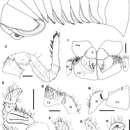Description
provided by Zookeys
Measurements. Male holotype: 33.5 long, 16.6 (2nd), 17.2 (8th) wide, 9.2 (2nd), 11.1 (9th - highest) height. Female: 46.9 mm long, 24.15 mm (2nd), 27.4 (8th - widest) wide, 13.1 (2nd), 19.5 mm (12th, highest) high (Fig. 2A).
Colouration of tergites dark brown with black posterior margin. Paratergite impressions and groove of thoracic shield orange. Legs, antennae and pleurites orange, head and collum dark brownish-black, eyes green.
Head: Eyes with >70 ocelli. Antennae short, protruding back to coxa 6. Antennomeres 1–4 with few longer setae, 5 and 6 densely pubescent (Fig. 4A). Antennomere 6 towards disc with single row of sensilla basiconica (Fig. 4A). Female with 36/45, male with 79/81 apical cones (Fig. 4B). Mouthparts not dissected.
Collum glabrous except few setae at margins.
Thoracic shield smooth and glabrous, few setae in grooves. Grooves deep (Fig. 2A). Tergites 3–12 smooth, paratergite tips of midbody tergites strongly projecting posteriorly (Fig. 2A).
Anal shield massive, with a steep edge (Fig. 2A), lacking pubescent area.
Endotergum inner section with numerous short triangular spines and long setae (Fig. 5A). Between ridge and inner area two rows of weakly impressed, circular cuticular impressions. Externally single, sparse row of marginal bristles (Fig. 5A). Bristles short, barely reaching to tergite margin.
First stigma-carrying plate with a well-rounded projecting apex (Fig. 2B).
Leg 1 with 2 or 3, 2 with 4–6, 3 with 10 ventral spines. Leg pairs 4–21 with 11–14 ventral spines. Coxa process strongly developed (Fig. 2C). Femur 2.1, tarsus 4.4 times longer than wide. All podomeres with only few setae (Fig. 2C).
Male gonopore typical for the genus (Fig. 2D).
Anterior telopod (Fig. 2E–H): Harp carrying three stridulation ribs (Fig. 2E). Shape usual for the genus, telopoditomere 4 with one large triangular spine and 2 or 3 smaller ones (Fig. 2F–H), apically with a weakly sclerotized spot (Fig. 2H).
Posterior telopod (Fig. 3A, B): Podomere 3 straight, 3.3 times longer than wide, slightly longer than immovable finger (Fig. 3A). Hollowed-out inner margin with one lobe and three sclerotized spines, posterior aspect with ca. 24 small crenulated teeth. Immovable finger basally wide, apically tapering, weakly curved towards podomere 3. Podomere 1 with few setae (Fig. 3A), podomere 2 only with few setae at anterior side, posterior side glabrous (Fig. 3B). Podomere 3 with only few marginal setae.
Female sexual characters: Vulva massive. Operculum well-rounded, protruding up to basal half of prefemur (Fig. 2I). Subanal shield massive, with shallow invagination at apical margin. Washboard with seven stridulation ribs on each side (Fig. 3C).
- license
- cc-by-3.0
- copyright
- Thomas Wesener, Daniel Minh-Tu Le, Stephanie F. Loria
- bibliographic citation
- Wesener T, Le D, Loria S (2014) Integrative revision of the giant pill-millipede genus Sphaeromimus from Madagascar, with the description of seven new species (Diplopoda, Sphaerotheriida, Arthrosphaeridae) ZooKeys 414: 67–107
- author
- Thomas Wesener
- author
- Daniel Minh-Tu Le
- author
- Stephanie F. Loria
Distribution
provided by Zookeys
Only known from the eastern lowland rainforest of Manombo, which is now isolated by vast areas of pseudosteppe from all other remaining rainforests.
- license
- cc-by-3.0
- copyright
- Thomas Wesener, Daniel Minh-Tu Le, Stephanie F. Loria
- bibliographic citation
- Wesener T, Le D, Loria S (2014) Integrative revision of the giant pill-millipede genus Sphaeromimus from Madagascar, with the description of seven new species (Diplopoda, Sphaerotheriida, Arthrosphaeridae) ZooKeys 414: 67–107
- author
- Thomas Wesener
- author
- Daniel Minh-Tu Le
- author
- Stephanie F. Loria

